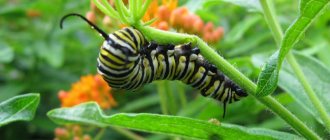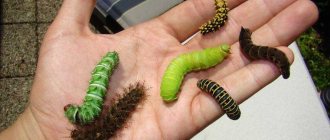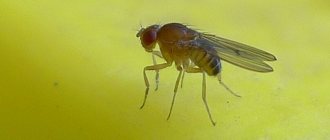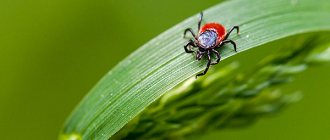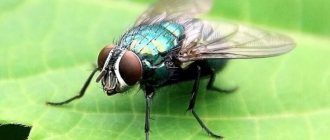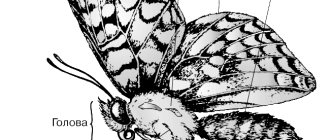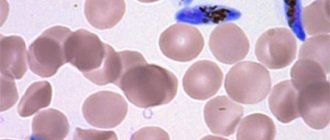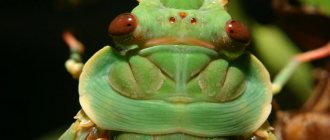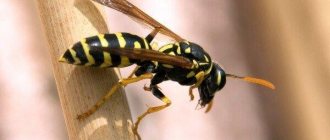Are caterpillars a separate species of insect?
Caterpillars are not representatives of a separate species, order or suborder of insects. This is one of the stages of development of butterflies - insects belonging to the order Lepidoptera. A caterpillar is a butterfly larva that hatches from an egg and eventually turns into a pupa, from which a beautiful butterfly will actually emerge.
Caterpillar
Until the transformation of a caterpillar into a butterfly occurs, the larva has to face many dangers. To survive, caterpillars use various methods of defense. Some scare away with their bright colors, others with an unpleasant odor, and still others are completely poisonous.
What is metamorphosis and why is it needed?
Metamorphosis, i.e. a life cycle with a series of successive transformations is a very successful acquisition in the struggle for existence. Therefore, it is widespread in nature and is found not only in insects, but also in other living organisms. Metamorphosis allows different stages of the same species to avoid competition among themselves for food and habitat. After all, the larva eats different food and lives in a different place; there is no competition between the larvae and adults. Caterpillars gnaw leaves, adult butterflies calmly feed on flowers - and no one bothers anyone. Through metamorphosis, the same species simultaneously occupies several ecological niches (feeding on both leaves and flowers in the case of butterflies), which also increases the species' chances of survival in an ever-changing environment. After the next change, at least one of the stages will survive, which means the entire species will survive and continue to exist.
Stages of butterfly development
Butterflies are insects with a full cycle of transformation, that is, they go through all stages of development:
- egg;
- larva (caterpillar);
- chrysalis;
- imago (adult).
Each stage of the transformation of a caterpillar into a butterfly takes time and has its own characteristics.
Where do caterpillars come from and how do they grow?
After mating, the butterfly lays eggs. The number of eggs in a clutch depends on what species the insect belongs to. Some butterflies lay up to 1000 eggs. But this does not mean that after a while 1000 larvae will be born. Butterfly eggs have many enemies among insects; in addition, their development is greatly influenced by humidity and air temperature.
Eggs are very diverse in shape. They can be oval, round, pear-shaped, flattened, cylindrical, or cone-shaped. The main color is light green, but there are also white, cream, blue, brown, red, yellow and other shades. Butterflies lay eggs one at a time or in groups of several.
The attitude towards future offspring varies greatly among different species of insects. Some females scatter eggs anywhere, others attach them to a food plant with a sticky secretion so that the emerging larvae do not have to look for food, while others lay them in a secluded place, covering them with their own hairs.
Butterfly eggs
The dense shell of the egg (chorion) protects the developing larva from mechanical stress and drying out. Inside the egg, in addition to the embryo, there is a supply of nutrients that ensure the growth and development of the future caterpillar.
The egg stage in most butterflies takes 1 to 3 weeks, but in some species it can last for months. The larva that emerges from the egg looks like a tiny worm. Its size, depending on the species, can vary from 1 to 5 mm. After the caterpillar emerges from the egg, it goes in search of food.
What a caterpillar eats is also determined by its belonging to a particular species. This is mainly plant food: flowers, leaves, berries and fruits. Some eat mosses, mushrooms, horny substances, wax, and plant bark. But there are also predators that eat aphids, mealybugs, and other caterpillars. Adequate nutrition is very important for the caterpillar, as it allows it to quickly gain weight and obtain enough material to form the cocoon of the future butterfly.
From caterpillar to chrysalis
As the caterpillar grows, it molts repeatedly. The average number of molts is from 4 to 7, but some species can molt up to 40 times. After each molt, the larva changes, and the changes concern not only size, but also color, and even body structure. In some species the transformations are almost invisible, while in others they are quite pronounced.
After the last molt, the caterpillar turns into a pupa. Shortly before pupation, the larvae stop eating. Many begin to behave restlessly, constantly moving around in search of the most suitable place. Some types of caterpillars look for a secluded place to pupate, others pupate openly. The process can occur on the ground, underground, on a leaf or stem of a plant. The caterpillar larva forms a cocoon by secreting silk threads. Throughout the formation of the cocoon, the larva remains in one place, firmly held by its paws.
It is in the cocoon that the caterpillar transforms into a butterfly.
From chrysalis to butterfly
While in chrysalis form, caterpillars are most vulnerable. They are motionless and cannot protect themselves from predators - birds and insects. The only thing that saves them is that the cocoon usually looks unpretentious and does not stand out much from the background of the environment.
Despite the fact that no movements are noticeable from the outside, many complex processes are taking place inside the cocoon at this time. The transformation from a larva to an adult (imago) in butterflies is called metamorphosis. The final form of the insect is almost completely different from the intermediate one, namely the larva. The only way to recognize the former caterpillar is by its legs.
In the case of butterflies, the caterpillar, once in a cocoon, secretes special substances, under the influence of which its body becomes liquid. In this mass, imaginal discs are preserved, that is, clusters of cells responsible for the formation of new tissues and organs of the future butterfly.
Birth of a butterfly
When the metamorphosis is completely completed, the insect secretes enzymes that corrode the shell, after which the butterfly can get out of the cocoon. First the head appears, then the body and legs squeeze through.
Immediately after the butterfly appears, it cannot yet fly. Her wings are wet and curled. The insect crawls higher and sits motionless until the wings straighten, dry and become strong. After this, the butterfly can go on its first flight in order to find a mating partner, then lay eggs and continue the butterfly genus.
How long does the transformation take?
The time that passes from the moment the pupa is formed until the butterfly appears varies significantly depending on the type of insect, climate zone and environmental conditions. In most cases, the rebirth process takes 2-3 weeks. But in some species, the pupa takes much longer to transform into a butterfly. Some species overwinter in pupal form, while others spend several years in this state. For example, in the fluffy cocoon moth, the pupal stage can last up to 8 years. If conditions outside are unfavorable, then the butterfly is in no hurry to appear and waits.
It is difficult to predict what a butterfly will be like based on the appearance of a caterpillar. Sometimes the larva and the adult insect are completely different, and in some cases the similarity is noticeable to the naked eye.
Amazing creatures
Caterpillars and their butterflies are not always alike; the color does not at all match the color of the future moth. Some larvae have similar features - spots, streaks of identical color. Only specialists and obvious fans of these insects can determine from which caterpillars and which butterflies emerge.
Butterfly caterpillars, photos and names are presented below.
- One of the most beautiful butterflies in our area is the peacock eye. The larva of this beauty is black in color with spines all over its body. The change in appearance is dramatic.
- Other black caterpillars will become wren butterflies.
- Amazing creation of bromeia. The caterpillar looks like a stick, and the butterfly has a very interesting woody color
- Green caterpillar with multi-colored pimples - cecropia.
- The black swallowtail has a simply irresistible color in green and blue tones. But there are also yellow dots on the caterpillar’s body.
- Dalcerida. It is not clear from the outside whether the larva will produce an insect or an animal. The appearance of the moth is no less unusual.
- The blue morpho is another creature that captivates with its appearance.
- Swallowtail is a butterfly well known in our area.
- The butterfly used to produce natural silk is the silkworm. She leads a sedentary lifestyle and practically does not use her wings for their intended purpose, despite the fact that their span reaches 60 mm. The larva forms a cocoon of silk threads up to 1500 m long.
Peacock butterfly and its caterpillar
Bramea and its caterpillar on the left, cecropia and its larva on the right
Black swallowtail butterfly
Dalcerida and its caterpillar on the left, blue morpho and its larva on the right
Swallowtail and its caterpillar on the left, silkworm and its larva on the right
Do caterpillars that manage to survive to the pupation stage always turn into moths - yes. Transformation always happens. However, in nature there are other insects whose larvae are similar to caterpillars, but they are called worms. At the end of the development process, they are destined to turn into beetles, bees, flies, and wasps. Sawflies are very similar to the larvae of butterflies; they are called false caterpillars.
People never cease to admire some types of butterflies; they keep them in the house, creating favorable living conditions for them.
When is it dangerous to help?
One day a man found a butterfly cocoon and took it home. He decided to observe the transformation process. The cocoon opened, and for several hours in a row this man observed the difficulties the butterfly had to go through in order to get out. She tried to get out through the small hole for quite a long time and suddenly the moment came when it seemed to him that the butterfly had given up and stopped fighting. It looked like she was stuck and completely motionless.
Taking pity on her, the man decided to help her and cut off the cocoon. Thanks to this, the butterfly got out of the cocoon, but its body was swollen like a caterpillar, its wings were small and unopened. The man expected her wings to strengthen and grow and her body to transform, but nothing else happened. The butterfly pitifully dragged its swollen body in a circle, now doomed to do this for the rest of its life.
Man, out of his kindness, did not understand that he had interfered with the natural process of nature. The efforts that the butterfly made were simply necessary for metamorphosis. Making its way through the narrow opening of the cocoon, the liquid from the butterfly's body would pass into the wings, making them large and strong for flight. By depriving the butterfly of its struggle, man doomed it to a miserable existence and deprived it of a wonderful future. Likewise, people become strong and successful and transform into a better image only when they go through certain difficulties and put in a lot of effort.
Sources:
https://www.lepidopterolog.ru/metamorf#:
https://www.krasnouhie.ru/zhiznennyj-cikl-babochek-metamorfoz-razvitie-babochki.html
https://www.danaida.ru/obsh/razm.htm
Requirements for growing a butterfly from a caterpillar at home
- Several caterpillars, the brighter and thicker the caterpillars, the more beautiful your butterflies will grow.
- The caterpillar's food is the grass or leaves on which you found the caterpillar.
- A butterfly incubator is an ordinary salofan bag or a three-liter jar.
- The waiting time is usually several weeks and not more than a month.
I will tell my story of how I raised a butterfly from a caterpillar at home (I was in third grade at the time) and the play, explaining your actions.
- I found several identical caterpillars on a bush and collected a dozen. I picked up a full package of these leaves and twigs. So, when you find the caterpillars, you should do the same. If you find a caterpillar on the asphalt and want to turn it into a butterfly, then search the Internet for this caterpillar and find out what plant it eats.
- At home, I made two incubators. I put twigs with leaves in the bag, filling 40% of the bag space. I made holes in the bag with a regular nail to allow air for my pets. Everything is easy here, just repeat. Do not skimp on the number of holes, and place the holes in the middle and top parts of the bag.
- I placed 5 of my caterpillars in one house, 5 in another. And he didn’t throw them in one pile, but spread them out evenly, although I think they might crawl back to their places on their own. Then he tied the bag on top and put it in a place where it was neither dark nor light. No matter what, the sun doesn’t fall on them, but no matter what, they don’t have eternal night. Place it on a corner of a shelf, or a table, or a bedside table, decide for yourself depending on your utility capabilities.
- I constantly looked and observed, the first days they only crawled along the branches and ate leaves. The spectacle was not exciting, boring and not interesting. But we have to wait!
- After about a week there was a lull, when I looked closely I saw that there were no caterpillars! There are cocoons, how they wrapped themselves in them, I don’t even know if I missed this moment. Further, it’s even more boring to watch them, they hang stupidly and that’s it. But we wait further.
- I don’t remember how many days passed there, but I saw the chrysalises and again missed the moment when the cocoon becomes a chrysalis. There was a suspicion that this was happening at night, but in fact, I just rarely looked there. I was interested in the end result.
- One fine morning, around 11 o'clock, I woke up from a strange noise. There was something rustling in the bag. I took a closer look and saw that a yellow butterfly was fluttering there. Surprisingly, it happened. Like a savage, I put my hand in the bag and began to catch it, naturally I scratched the enamel on its wings with my fingers, gently grabbed it by the abdomen and on the balcony released it into the street and it flew away. I returned to my bags and saw a small head bursting out of the pupa into the light of day. She worked hard and for a long time to get out. Sometimes I wanted to reach out and help, but I stopped myself with the thought that I could only do harm. So don’t stop nature from doing its thing, don’t pretend to be surgeons!
- And when the butterfly crawled out before my eyes, I put my hand up and it, having just been born, was not afraid of me at all. I could pick her up and carry her, put her down and pick her up again, she only climbed, but didn’t fly. There was a thought that she was disabled and wouldn’t fly, but still, she flew up and continued to contact me without fear, allowing herself to be picked up (naturally not by the wings). This is just a miracle! I now know that she didn’t fly because her wings needed to dry.
With it, I did the same as with the first butterfly, took it to the balcony and released it, it circled around me for a long time, as if it was saying goodbye or did not want to part, but the smell of freedom gave it new sensations and it fluttered high into the air. That’s what I thought at the time, isn’t it impressive? ?
Unfortunately, the remaining 8 caterpillars died. Nothing hatched from their pupae. Perhaps they did not have enough food supplies, perhaps the conditions were not the same or there were few holes, but most likely it was a bit dry, since they need 80-60% humidity. But in any case, out of 10 caterpillars I have, 2 butterflies were born without much care.
We invite you to read: Advantage for nursing cats
Well, in conclusion, I’ll tell you that you can make money from butterflies (I wrote about this in the article Fear of Retirement), but growing a butterfly at home is not difficult and you don’t need any investment.
